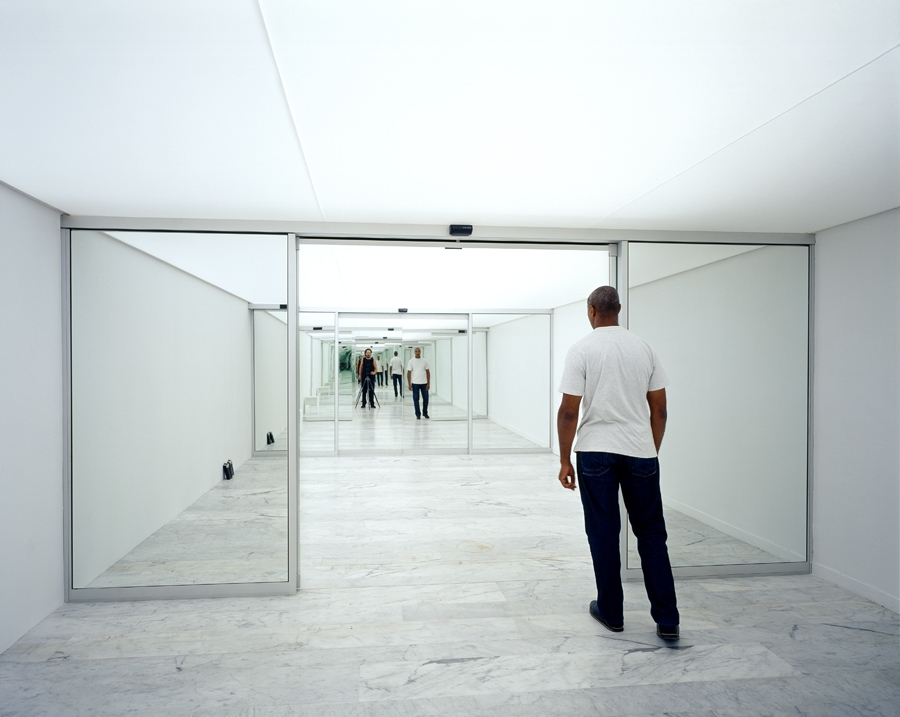Forgotten what artistic director Jessica Morgan has titled this biennial? There’s a chance you might in an exhibition that contains the works of over 100 artists or artist groups. But don’t worry. Help is at hand. Three cover versions (by French musician Joakim) of the 1983 Talking Heads song from which the show gets its title blast from speakers outside the exhibition halls; a wallpaper of pixelated flame and smoke by London-based design studio El Ultimo Grito covers what might otherwise be white gallery walls inside; there’s an Yves Klein fire painting, Jack Goldstein’s Burning Window installation (1977), Eduardo Basualdo’s The Island (2009), a claustrophobic house constructed out of the burnt remains of a building in Buenos Aires, Camille Henrot’s tar-soaked collection of Augmented Objects (2010) and the charcoal remains of a forest fire in Cornelia Parker’s Heart of Darkness (2004); meanwhile, outside again, the Biennale Square features two shipping containers containing remains of Korean War massacre victims (you can see the fragments of bone and skulls, ordered in plastic tubs, through the container windows) discovered down a mine in 1992 – a work (although it seems wrong to call it that) by South Korean Minouk Lim titled Navigation ID (2014), and Stirling Ruby’s smoking Stoves (2014), working wood-burning stoves inspired by the artist’s childhood memories of life on a Pennsylvania farm. Although next to the shipping containers and their contents, they, and their tall chimneys and plumes of smoke, suggest something else entirely.
The Biennale, now in its tenth edition and one of the best-attended art events in the world, was famously founded back in 1995 in memory of the spirit of the city’s 1980 pro-democracy uprising and its brutal repression. It’s a history that seems consumed with such a gluttonous abandonment by Minouk Lim’s work, which opened with a ceremony in which the relatives of the massacre victims were greeted by the mothers of those who died in the Gwangju Uprising, that a notion of clearing out the cupboard (another form of burning down the house) is almost overwhelming. It continues early into the interior show, where a retrospective of videos and reconstructed costumes document South Korean Lee Bul’s quite brilliant early performances, many of them attacking prejudice against women, from the late 1980s and early 1990s, among them Abortion (1989), in which the artist is suspended upside-down, in pain and naked, while reciting a monologue. Together the works establish the Biennale’s guiding theme of destruction, memorial and reconstruction.
If, like me, you read the right kind of science fiction on the flight into Gwangju, you might be reminded of Solaris, the planet from Stanislaw Lem’s 1961 novel (of the same title) that mirrors its visitors’ subconscious memories and expectations back to them. That’s a feeling that’s enhanced by a series of works including Carsten Höller’s Sliding Doors (2014), a reworking of a 2003 work in which objects (the doors) reflect and react to subjects (the viewers), Allora & Calzadilla’s Temperament and the Wolf (2014), in which a tunnel of around 30 people each offer a handshake to (or ignore) the incoming Biennale visitor, Pierre Huyghe’s Name Announcer (2011/14), in which your name gets announced as you enter the gallery, and to a lesser extent, Koo Jeong A’s Its Soul (2014), a gallery wall that moves and shakes at set times during the day. While that pixelated wallpaper, and a work by Urs Fischer, 38 E. 1st St. (2014), featuring a suite of rooms and photographic wallpaper that constitute a 1:1 reproduction of the interior of the artist’s New York apartment, serves to give you the impression that the exhibition is also somehow conscious of its own eventual mediation.
But if there’s a definite sense of recoil from the Biennale’s bombastic curating (and the presence of so many biennial favourites, many of whom reiterate older works), Burning Down the House also offers a number of quieter moments, worth spending extended time with, that linger long in the conscious memory. Among them are Sri Lankan Lionel Wendt’s early-twentieth-century modernist photographs, Anand Patwardhan’s We Are Not Your Monkeys (1993), a stunningly rich video meditation on the theory of Aryan conquest and the caste system in India, and A.A. Bronson and friends’ AA Bronson’s House of Shame (2014), a dreamy reflection on sexuality and spirituality, effectively a group show in the Spiral Pavilion, just outside the Biennale Hall. In the end, then, this biennial offers a little something for everyone: curators, viewers and artists alike.
This article was first published in the Spring 2015 issue of ArtReview Asia.
